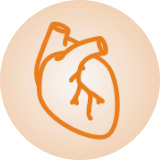Think Fabry, think early treatment to help slow or prevent life-threatening disease progression1,2
Fabry disease is classified into two main phenotypes:3-5
- Classic – absent of very low α-GAL A activity, multiple-organ systems involved, presentation generally begins in childhood
- Nonclassic – also referred to as late-onset, varying levels of residual α-GAL A activity and symptoms are more variable, most frequently beginning in adulthood
Considerations for initiating ERT in each of the following:3

- Advanced, elderly age of the patient
- Severe comorbidity
ERT should be considered and is appropriate in adult males with classic Fabry disease (symptomatic or asymptomatic)
Treatment decisions may be influenced by3:

ERT should be considered in adult classic females upon early signs of renal, cardiac, CNS complications, pain, and GI issues3,7
Signs/symptoms suggesting major organ involvement3,7

Proteinuria/albuminuria not attributable to other causes, evidence of renal impairment

Symptomatic cardiac disease not due to other causes (dyspnea, palpitation, syncope, chest pain)

Stroke or TIA
Neuropathic pain, pain crises, Fabry disease neuropathy
Neuropathic pain, pain crises, Fabry disease neuropathy
Exercise intolerance and impaired sweating

Lab/histological/imaging evidence of injury to kidney, heart, or CNS3,7

GFR <90mL/min/1.73m2, adjusted for age >40 years, persistent albuminuria >30 mg/g, podocyte foot process effacement on renal biopsy
Moderate or severe GL-3 inclusions in a range of renal cell types

Asymptomatic cardiac disease (cardiomyopathy or arrhythmia, cardiac fibrosis on contrast cardiac MRI)

Silent strokes, cerebral white matter lesions (on brain MRI)

Lab/histological/imaging evidence of injury to kidney, heart, or CNS3,7

GFR <90mL/min/1.73m2, adjusted for age >40 years, persistent albuminuria >30 mg/g, podocyte foot process effacement on renal biopsy
Moderate or severe GL-3 inclusions in a range of renal cell types

Asymptomatic cardiac disease (cardiomyopathy or arrhythmia, cardiac fibrosis on contrast cardiac MRI)

Silent strokes, cerebral white matter lesions (on brain MRI)
Recommendations for initiation of ERT in pediatric patients with Fabry disease6

ERT should be considered if signs and symptomswarranting tr eatment suggest major organ involvement are present in boys or girls 2 years and older.
Signs/symptoms warranting treatment6

Neuropathic pain crises/Fabry neuropathy

Decline in eGFR, pathological albuminuria/proteinuria, creatinine elevation, cellular GL-3 accumulation, evidence of tissue damage such as podocyte effacement

Cardiomyopathy or arrhythmia (including sinus bradycardia)
Recurrent abdominal pain and diarrhea (excluding alternative causes)
Exercise intolerance and impaired sweating

Serious discussion regarding the timing of ERT initiation (balancing risks and benefits) is recommended by age 8–10 years for asymptomatic boys with classic GLA variants.
Signs/symptoms warranting treatment6

Neuropathic pain crises/Fabry neuropathy

Decline in eGFR, pathological albuminuria/proteinuria, creatinine elevation, cellular GL-3 accumulation, evidence of tissue damage such as podocyte effacement

Cardiomyopathy or arrhythmia (including sinus bradycardia)
Recurrent abdominal pain and diarrhea (excluding alternative causes)
Exercise intolerance and impaired sweating

- Decision to defer ERT should be based on comprehensive longitudinal monitoring for the development of clinical symptoms and signs of disease
- Family history of the female patients should also be considered
Signs/symptoms warranting treatment6

Neuropathic pain crises/Fabry neuropathy

Decline in eGFR, pathological albuminuria/proteinuria, creatinine elevation, cellular GL-3 accumulation, evidence of tissue damage such as podocyte effacement

Cardiomyopathy or arrhythmia (including sinus bradycardia)
Recurrent abdominal pain and diarrhea (excluding alternative causes)
Exercise intolerance and impaired sweating
Patients younger than 2 years of age were not included in clinical studies of Fabrazyme. The safety and efficacy of Fabrazyme in patients younger than 2 years of age have not been evaluated.
Think Fabry, think regular profile-based assessments
The following assessments enable you to evaluate your patients on a regular basis. In addition to monitoring GL-3 and lyso-GL-3, this guidance considers other important factors that can help you monitor the progression of Fabry disease.3,6-10
These assessments are based on published guidelines and recommendations developed by the Fabry Registry Board of Advisors, a group of physicians who have experience in managing patients with Fabry disease. The Fabry Registry is sponsored by Sanofi.7-11
The Recommended Schedule of Assessments represents the core Fabry disease—related assessments that allow evaluation of a patient’s disease progression over time. Physicians will determine the actual frequency of necessary assessments according to a patient’s individualized need for medical care and routine follow-up. Assessments appropriate to individual patients may vary depending upon the clinical judgment of the treating physician, and the patient's need.
Disease-related assessments for patients ≥18 years of age3,11
*Frequency of assessment information is from the Fabry Registry Schedule of Assessments.
aDirectly measuring glomerular filtration rate (GFR) is recommended if a more precise evaluation is desired.
b24 hour or first morning void urine for protein, creatinine, and albumin.
cIf electrocardiogram is abnormal and/or clinical symptoms arise, Holter monitoring is recommended.
dAnnual 24-hour Holter monitoring is recommended for males 30 years of age or older and females 40 years of age or older.
eCardiac MRI is recommended at Fabry diagnosis for patients ages 25 and older. It is recommended to be performed under age 25 if cardiac hypertrophy or significant arrhythmia is present.
e1If first MRI is abnormal: 1) patients with moderate or severe left ventricular hypertrophy (LVH) receiving ERT should have MRI annually; 2) patients with significant arrhythmia should have MRI at least every 2 years or at frequency factoring cardiac disease severity and the physician’s clinical judgment; 3) males with no or mild LVH receiving ERT should have MRI every 2 years.
e2If first MRI is normal, repeat every 5 years or earlier if ECG/ECHO results are abnormal on annual exam.
fIf spirometry is abnormal, perform yearly.
gAt the time of an event, a cranial MRI should also include diffused weighted images and DWI/ADC.
hMonitor yearly if retinal vessel tortuosity noted.
Disease-related assessments for patients <18 years of age*7-11
*Initiation of Laboratory Tests, Imaging, and Other Studies: There is variability in the clinical complications and progression of Fabry disease. Children are at risk for life-threatening complications. There are no biomarkers available to discern mildly affected from severely affected patients. In children with a family history of early presenting or severe disease, complete evaluations should be done at the time of diagnosis. Other patients should be completely evaluated at no later than 5 years of age.
†Frequency of assessment information is from the Fabry Registry Schedule of Assessments.
aPatients receiving ERT are recommended to undergo these evaluations every 6 months; for those not on ERT or with milder disease, once per year may be sufficient.
bBlood pressure should be measured 3 times at each assessment; only the last 2 measurements should be recorded.
cGFR should be measured directly every 24−36 months until age 15, and annually thereafter. If direct measurement is not possible, serum creatinine levels should be obtained at the recommended intervals for an estimation of GFR, which is a less sensitive method.
dFirst morning voided urine for protein, albumin, and creatinine in order to calculate a protein/creatinine ratio and albumin/creatinine ratio. Protein, albumin, and creatinine measurements can also be performed on timed samples (eg, 24 hours).
eElectrocardiogram should be performed starting at ages 10–12 years. If abnormal and/or clinical symptoms arise, Holter monitoring is recommended.
fEchocardiogram should be performed starting at ages 10–12 years.
gCardiac MRI is recommended to be performed in patients under age 25 if cardiac hypertrophy or significant arrhythmia is present.
hCranial MRIs should be performed at ages 10, 15, and 18 years.
h1At the time of a cerebrovascular event, a cranial MRI should also include diffused, weighted images and apparent diffusion coefficient (DWI/ADC).
iMonitor yearly if retinal vessel tortuosity noted.
jAudiologic evaluation should be performed at the earliest age that is practical.
Monitor pediatric patients with Fabry disease for new or worsening symptoms
Boys and girls with Fabry disease begin developing symptoms at an early age (median age of 6 years for boys and 9 years for girls).9
Treatment-related assessments11
Adverse events relating to Fabrazyme (agalsidase beta) should be reported to Sanofi Medical Information at 800-745-4447, Option 2.
Think Fabrazyme: treatment you can trust
For both adult and pediatric patients with Fabry disease, regardless of genotype or severity.
Request a rep or attend an educational program
Connect with a representative to learn more, or sign up for invitations to upcoming educational programs.

IMPORTANT SAFETY INFORMATION
IMPORTANT SAFETY INFORMATION
|
WARNING: HYPERSENSITIVITY REACTIONS INCLUDING ANAPHYLAXIS Patients treated with enzyme replacement therapies have experienced life-threatening hypersensitivity reactions, including anaphylaxis. Anaphylaxis has occurred during the early course of enzyme replacement therapy and after extended duration of therapy. Initiate FABRAZYME in a healthcare setting with appropriate medical monitoring and support measures, including access to cardiopulmonary resuscitation equipment. If a severe hypersensitivity reaction (e.g. anaphylaxis) occurs, discontinue FABRAZYME and immediately initiate appropriate medical treatment, including use of epinephrine. Inform patients of the symptoms of life-threatening hypersensitivity reactions, including anaphylaxis and to seek immediate medical care should symptoms occur [see Warnings and Precautions (5.1)]. |
WARNINGS AND PRECAUTIONS
Hypersensitivity Reactions Including Anaphylaxis
In clinical trials and post-marketing experience, approximately 1% of patients developed anaphylactic or severe hypersensitivity reactions, some life-threatening, during Fabrazyme infusion. Reactions have included localized angioedema (including swelling of the face, mouth, and throat), bronchospasm, hypotension, generalized urticaria, dysphagia, rash, dyspnea, flushing, chest discomfort, pruritus, and nasal congestion. Consider pretreating with antihistamines, antipyretics, and/or corticosteroids; however, reactions may still occur.
In Fabrazyme clinical trials, some patients developed IgE antibodies or skin test reactivity specific to Fabrazyme.
- Higher incidences of hypersensitivity reactions were observed in adult patients with persistent anti-Fabrazyme antibodies, and in those with high antibody titers compared with antibody negative adult patients.
- Consider testing for IgE antibodies in patients who experienced suspected hypersensitivity reactions and consider the risks and benefits of continued treatment in patients with anti-Fabrazyme IgE antibodies. Rechallenge of these patients should only occur under the direct supervision of qualified personnel, with appropriate medical support measures readily available.
Infusion-Associated Reactions
In Fabrazyme clinical trials, 59% of patients experienced infusion-associated reactions (IARs), some of which were severe. IARs are defined as those occurring on the same day as the infusion. The incidence of these reactions was higher in patients who were positive for anti-Fabrazyme antibodies than those negative for anti-Fabrazyme antibodies.
- Consider pretreatment with antipyretics, antihistamines, and/or corticosteroids to reduce the risk of IARs; however, they may still occur.
- If a mild or moderate IAR occurs, consider holding the infusion temporarily, decreasing the infusion rate, and/or reducing the Fabrazyme dosage. If a severe IAR occurs, discontinue Fabrazyme immediately and initiate appropriate medical treatment as needed. Assess the risks and benefits of readministering Fabrazyme and monitor patients closely if readministering.
- Patients with advanced Fabry disease may have compromised cardiac function, which may predispose them to a higher risk of severe complications from IARs. Closely monitor patients with compromised cardiac function receiving Fabrazyme.
Common Adverse Reactions
Adverse reactions reported (≥20%) were upper respiratory tract infection, chills, pyrexia, headache, cough, paresthesia, fatigue, peripheral edema, dizziness, and rash.
Please see full Prescribing Information, including Boxed WARNING
IMPORTANT SAFETY INFORMATION
Show moreIMPORTANT SAFETY INFORMATION
|
WARNING: HYPERSENSITIVITY REACTIONS INCLUDING ANAPHYLAXIS Patients treated with enzyme replacement therapies have experienced life-threatening hypersensitivity reactions, including anaphylaxis. Anaphylaxis has occurred during the early course of enzyme replacement therapy and after extended duration of therapy. Initiate FABRAZYME in a healthcare setting with appropriate medical monitoring and support measures, including access to cardiopulmonary resuscitation equipment. If a severe hypersensitivity reaction (e.g. anaphylaxis) occurs, discontinue FABRAZYME and immediately initiate appropriate medical treatment, including use of epinephrine. Inform patients of the symptoms of life-threatening hypersensitivity reactions, including anaphylaxis and to seek immediate medical care should symptoms occur [see Warnings and Precautions (5.1)]. |
WARNINGS AND PRECAUTIONS
Hypersensitivity Reactions Including Anaphylaxis
In clinical trials and post-marketing experience, approximately 1% of patients developed anaphylactic or severe hypersensitivity reactions, some life-threatening, during Fabrazyme infusion. Reactions have included localized angioedema (including swelling of the face, mouth, and throat), bronchospasm, hypotension, generalized urticaria, dysphagia, rash, dyspnea, flushing, chest discomfort, pruritus, and nasal congestion. Consider pretreating with antihistamines, antipyretics, and/or corticosteroids; however, reactions may still occur.
In Fabrazyme clinical trials, some patients developed IgE antibodies or skin test reactivity specific to Fabrazyme.
- Higher incidences of hypersensitivity reactions were observed in adult patients with persistent anti-Fabrazyme antibodies, and in those with high antibody titers compared with antibody negative adult patients.
- Consider testing for IgE antibodies in patients who experienced suspected hypersensitivity reactions and consider the risks and benefits of continued treatment in patients with anti-Fabrazyme IgE antibodies. Rechallenge of these patients should only occur under the direct supervision of qualified personnel, with appropriate medical support measures readily available.
Infusion-Associated Reactions
In Fabrazyme clinical trials, 59% of patients experienced infusion-associated reactions (IARs), some of which were severe. IARs are defined as those occurring on the same day as the infusion. The incidence of these reactions was higher in patients who were positive for anti-Fabrazyme antibodies than those negative for anti-Fabrazyme antibodies.
- Consider pretreatment with antipyretics, antihistamines, and/or corticosteroids to reduce the risk of IARs; however, they may still occur.
- If a mild or moderate IAR occurs, consider holding the infusion temporarily, decreasing the infusion rate, and/or reducing the Fabrazyme dosage. If a severe IAR occurs, discontinue Fabrazyme immediately and initiate appropriate medical treatment as needed. Assess the risks and benefits of readministering Fabrazyme and monitor patients closely if readministering.
- Patients with advanced Fabry disease may have compromised cardiac function, which may predispose them to a higher risk of severe complications from IARs. Closely monitor patients with compromised cardiac function receiving Fabrazyme.
Common Adverse Reactions
Adverse reactions reported (≥20%) were upper respiratory tract infection, chills, pyrexia, headache, cough, paresthesia, fatigue, peripheral edema, dizziness, and rash.
Please see full Prescribing Information, including Boxed WARNING
INDICATION AND USAGE
Fabrazyme® is indicated for the treatment of adult and pediatric patients 2 years of age and older with confirmed Fabry disease.
References: 1. Fabrazyme® (agalsidase beta). Prescribing Information 2024. 2. Wanner C et al. Mol Genet Metab. 2019;126(3)210-211. 3. Ortiz A et al. Mol Genet Metab. 2018;123(4):416-427. 4. Germain DP. Orphanet J Rare Dis. 2010;5:30. 5. Arends M et al. Mol Genet Metab. 2017;121:157-161. 6. Hopkin R et al. Mol Genet Metab. 2016;117:104-113. 7. Biegstraaten M et al. Orphanet J Rare Dis. 2015;10:36. 8. Spada M et al. Ital J Pediatr. 2017;43(1):1. 9. Martins AM et al. J Pediatr. 2009;154(4 suppl):S19-S31. 10. Hopkin RJ et al. Pediatr Res. 2008;64(5):550-555. 11. Fabry Registry. Schedule of Assessments.
